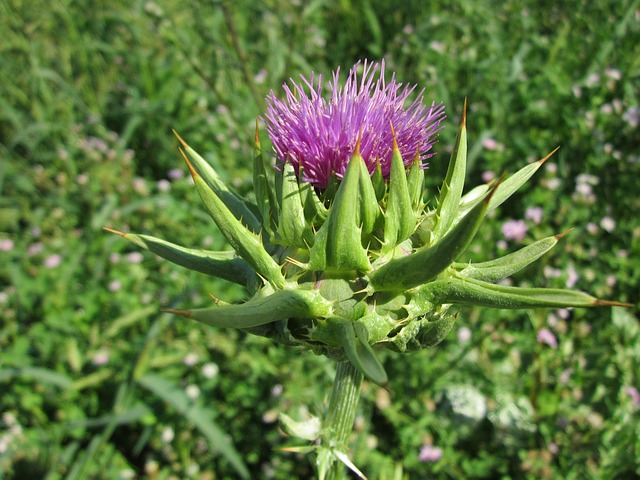Milk thistle is my centrepiece in restoring the healthy functioning of the liver. It not only protects the liver from damage, it actually stimulates the growth of healthy new cells. Amazingly, studies have shown that this humble herb can reverse liver damage, protect against hepatitis and cirrhosis, speed recovery from jaundice, and even protect laboratory animals from kidney toxicity, normally caused by a potent drug. A fifteen-year study in Sweden showed that the active ingredient in milk thistle, called silymarin, protected against potentially fatal mushroom poisoning.
Silymarin is now a standard part of emergency room [ER] treatment for mushroom poisoning in Europe. Another study of over 2,600 patients with liver disorders found remarkable improvement with daily doses of milk thistle extract. After two months, 63 per cent of patients reported that their symptoms had completely disappeared. They no longer suffered from nausea, itching, bloating, lack of appetite, and fatigue. Laboratory tests found that elevated liver enzymes, a signal that the liver is inflamed, had decreased by an average of 40 per cent. Other studies have shown equally impressive results and also confirmed the improvements with actual liver biopsies. Silymarin can protect the liver from a wide range of potential poisons, from alcohol to mushrooms to prescription drugs [without interfering with the drugs’ potency].
Not surprisingly, an herb this potent has long been known to folklorists and has been in use for thousands of years. Research into its liver-protecting properties began just over four decades ago in Germany when the active ingredient, silymarin, was first discovered. I sometimes think of silymarin as a Secret Service Agent taking a bullet for the president, because the compound binds to receptors within the liver that are vulnerable to toxins, thus preventing their damaging effects. Silymarin has been used to treat cirrhosis, hepatitis, gallstones, and skin disorders, like psoriasis and acne. In fact, herbalists find it useful in any chronic illness that stresses the liver.
Silymarin In Practice
Milk thistle was a key to healing Cybil’s skin, a patient of mine. My experience has been that acne can be a sign of poor liver detoxification. Liver problems may not manifest themselves in the liver at all. Instead, they may show up in other parts of the body, where toxins congregate — like escaped convicts. One reason adolescents break out so often is because their livers are not yet accustomed to sudden hormonal surges. Cybil’s physician was trying to quiet the erupting fires in her face, without understanding their source. Cybil was shutting off her security system, while the toxic bandits robbed her of essential nutrients, depriving her of her health.
I wanted to wean Cybil from her drugs, treat her for the yeast that was incubating in her gut because of constant doses of antibiotics and support her liver function.
First, I placed her on a weeklong detoxification diet. Day one consisted entirely of vegetables; on day two, she could add rice; on day three, fruit, especially lemons as juice, or salads; and, on the fourth, fish. On day five, she substituted beans for her vegetable, and on day six she was allowed to eat all the foods.
Liver Detox
“Doctor,” said Cybil, “this diet sounds like hell. Why do I have to do it?” I explained that this short detoxification programme would lay the foundation for recovery of her liver. On day one, we were removing any foods to which she might be allergic. On day two, rice would help absorb water and toxins in her gut, so the lining would not be irritated. On day three, fruits and lemon would stimulate detoxification in her liver. By day four, she was adding back protein, and on day five, fibre and vegetables, like broccoli and beets, which also stimulate liver detoxification. Each day, she would also consume one teaspoon of flaxseed powder in an eight-ounce glass of water. Flaxseed helps bulk up bowel movements and absorbs bacteria and toxins. It also contains healthy omega-3 oils and fibres, called lignans, which are known to reduce the risk of cancer.
“All right,” she agreed. “I’ll tough it out.” After the week-long detox, Cybil followed a maintenance diet that eliminated fried and excessively fatty foods, which are often hard for the liver to handle. I literally ‘prescribed’ daily doses of the vegetables and fruits that are known to support liver detoxification, including lemons, beets, and broccoli. I asked her to stop consuming beer, pizza, and sugars, all of which stimulate yeast and were a staple of her diet.
Finally, and most importantly, we addressed Cybil’s liver directly. Vitamin C, at 2,000mg a day in four divided doses, was important as an antioxidant and general detoxifier. B-complex, zinc, and magnesium were added because the liver needs these nutrients in order to function well. N-acetyl cysteine [NAC], a special form of an amino acid, is a powerful liver protectant, because it stimulates the liver’s most powerful antioxidant, glutathione. I suggested Cybil take 250mg four times a day. Most important, however, was silymarin. I prescribed 400mg daily.
The rest of her story is short and sweet. She improved steadily over three months. My receptionist, Amy, didn’t recognise Cybil the last time she came into the office for a consultation. Her complexion was smooth; almost flawless. She looked wonderful, thanks to silymarin, which had helped her liver to help her.

